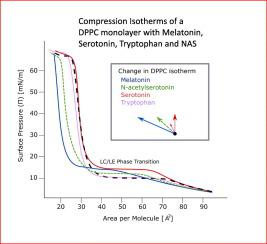Biochimica et Biophysica Acta (BBA) - Biomembranes ( IF 3.4 ) Pub Date : 2020-05-22 , DOI: 10.1016/j.bbamem.2020.183363 Morgan Robinson 1 , Stephen Turnbull 1 , Brenda Yasie Lee 1 , Zoya Leonenko 2

|
Melatonin is a neurohormone that has been shown to be protective in Alzheimer's diseases against amyloid-β (Aβ) toxicity, which involves interaction of Aβ with neuronal membrane. Non-specific interactions of melatonin with cell membrane may play a physiological role in this process by preserving membrane fluidity. In the brain, melatonin is derived from the amino acid tryptophan through a pathway that includes serotonin and N-acetylserotonin (NAS). How these molecules affect the membrane properties is not understood. In this work, we studied interactions of melatonin and its metabolic precursors tryptophan, serotonin and NAS with dipalmitoylphosphatidylcholine (DPPC) monolayers at the air-water interface using Langmuir monolayer technique. Analysis of compression isotherms, phase transitions and compressibility moduli indicate that all four molecules alter the DPPC monolayer properties in a structure and concentration dependent manner. This effect was most pronounced for melatonin followed by NAS. Melatonin and NAS both decreased the compressibility modulus and shifted the LE/LC phase transition suggesting an increase in the membrane fluidity. Tryptophan and serotonin caused less pronounced effects on the DPPC isotherm. These differences suggest different interaction mechanisms and may be attributed to the interplay between electrostatic and hydrophobic interactions of these molecules with the zwitterionic DPPC headgroups which correlate with water solubility and oil partition coefficients (LogS and LogP) of each the four molecules. The results here demonstrate how the physiochemical properties of indoles can affect lipid membranes which may shed light on the functional significance of these important neurochemicals and the neuroprotective mechanisms of melatonin.
中文翻译:

褪黑素,血清素,色氨酸和NAS对DPPC单层生物物理特性的影响。
褪黑激素是一种神经激素,已被证明在阿尔茨海默氏病中可抵抗淀粉样β(Aβ)毒性,该毒性涉及Aβ与神经元膜的相互作用。褪黑激素与细胞膜的非特异性相互作用可通过保持膜的流动性在此过程中发挥生理作用。在大脑中,褪黑激素通过色氨酸和N的途径从氨基酸色氨酸衍生而来。-乙酰5-羟色胺(NAS)。这些分子如何影响膜的性质尚不清楚。在这项工作中,我们使用Langmuir单层技术研究了褪黑素及其代谢前体色氨酸,5-羟色胺和NAS与二棕榈酰磷脂酰胆碱(DPPC)在空气-水界面上的相互作用。压缩等温线,相变和压缩模量的分析表明,所有四个分子均以结构和浓度依赖性方式改变DPPC单层性能。对于褪黑激素其次是NAS,这种作用最为明显。褪黑激素和NAS均降低了可压缩模量,并转移了LE / LC相变,表明膜流动性增加。色氨酸和5-羟色胺对DPPC等温线的影响较小。这些差异暗示了不同的相互作用机制,并且可能归因于这些分子与两性离子DPPC头基之间的静电和疏水相互作用之间的相互作用,这与四个分子各自的水溶性和油分配系数(LogS和LogP)相关。此处的结果证明了吲哚的理化特性如何影响脂质膜,这可能揭示了这些重要神经化学物质的功能意义以及褪黑激素的神经保护机制。



























 京公网安备 11010802027423号
京公网安备 11010802027423号